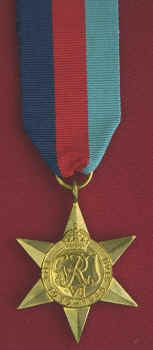The 1939-1945 Star:

Army personnel had to complete 6 months service in an operational command. Airborne troops qualified if they had participated in any airborne operations and had completed 2 months service in a fully operational unit. Air Force personnel had to participate in operations against the enemy providing that 2 months service had been completed in an operational unit. Non-aircrew personnel had to complete 6 months service in an area of operational army command. Naval personnel qualified if they completed 6 months service, and at least 1 voyage was made through an operational area.
The 1939-45 Star is a six–pointed star of yellow copper zinc alloy, with a height of 44mm and maximum width of 38mm. The obverse has a central design of the Royal Cipher, surmounted by a crown. The cipher is surrounded by a circlet containing the words ‘The 1939-45 Star'.
The reverse is plan, with the recipient's name engraved only for Australian's and South African's. The ribbon has three vertical stripes of dark blue, red and light blue. The dark blue stripe represents the Naval Forces and the Merchant Navy, the red stripe the Armies and the light blue stripe the Air Forces.
The ribbon for this medal, along with those of the other Second World War campaign stars, is reputed to have been designed by King George VI, with the three equal bands representing the equal contributions towards victory of the Royal Navy, Army, and the Royal Air Force respectively. The medal is valued between £10 - £12. However, if the Battle of Britain clasp is present, then the value jumps to between £450 and £550.